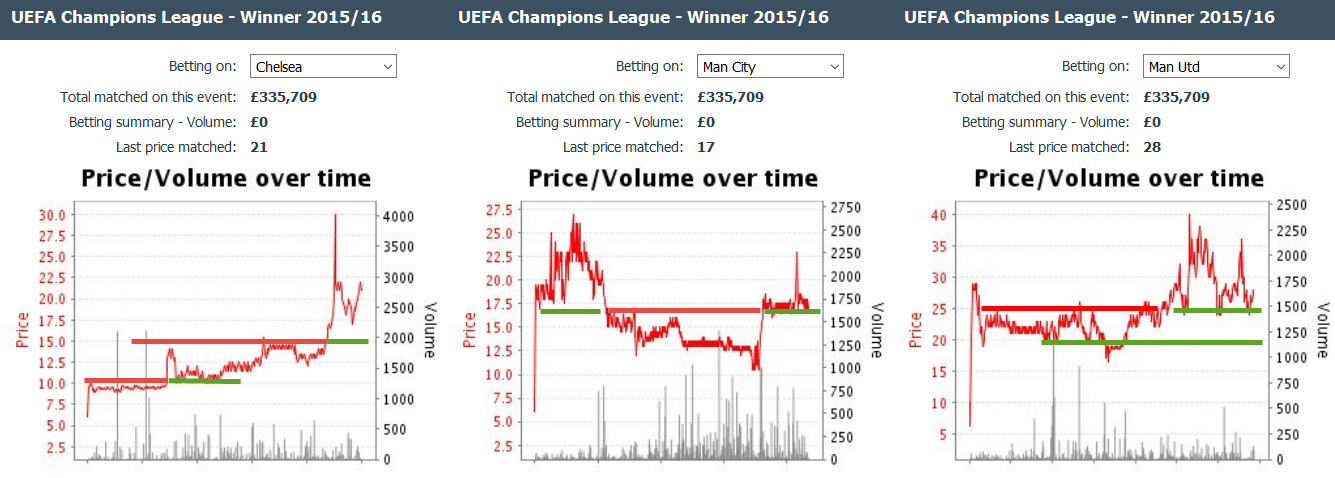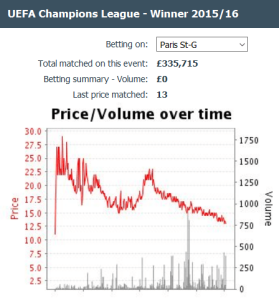Champions League is unfolding full speed, halfway into the group stage. At the same time, gamblers are struggling to keep up the pace in an effort to not miss any betting opportunity. Several among them have already placed their bets on this year’s winner. No, Barcelona does NOT appear as the top favorite anymore, ceding its place to Bayern Munich?
Let us take a look at how the betting market evolves, discussing in particular on which odds movements we should stay focused.
But, before we start the chart analysis, I should rather briefly explain what we are about to examine on the images that follow. I have a feeling that several players still find it difficult to fully grasp how things work on the odds graphs and how odds fluctuations are portrayed with dots and lines. Therefore, it might be a good idea to go over the basics again so that both seasoned bettors and novices alike can check on their skills.
The betting odds are constantly changing. This change occurs due to demand and supply forces in the gambling market. If a bet (say, the home win) records high demand, the corresponding odds are driven lower because in the mind of a great number of bettors this event is more likely to come true. At the same time, as the bet’s counter-part (say, the away win) does not attract the interest of bettors, gaming operators and traders on betting exchanges are happy to offer better/higher odds on that bet. In essence, they provide the supply in the market so that more players are intrigued to place their cash on the away team instead of the home team.
This battle between demand and supply will eventually settle at a price, the so-called equilibrium point, as it is generally the case in worldwide trade. Equilibrium is reached when there are enough players willing to bet on every possible event of a game. For example, in soccer, that’s when there are enough bettors asking to back all two events of a soccer game – or three including draw.
So, what exactly do we mean by “enough”?
“Enough” is… enough when the odds represent roughly the percentage of bettors expected to back a specific bet’s side. Suppose we have a bet with two possible outcomes, a home and an away win, and bookmakers are willing to pay 1.50 and 3.00 on each outcome, respectively. Then, we can expect that about two thirds of bettors are backing the home team, while one third are risking on the away team’s win. Let’s not forget, gaming operators must make a profit too. That being said, bookmakers will always forge the odds on their favor, offering for example odds at 1.35 on the home team and 2.85 on the away team. Bettors have to pay a premium out of their winnings, which depends on the “vigorish” – the profit margin set by each bookmaker.
Since we talk about a long-term betting market, as it is the case when we bet on the odds for the winner of Champions League, odds fluctuations happen in the course of a very long period of time. The bet is available for several months as the Champions League’s consecutive stages take place one after the other. Consequently, depending on the latest results, bettors will push the odds up and down till equilibrium in the market is achieved every time.
In fact, we try to identify these specific equilibrium points on the charts, or any imbalances that may occur in the betting market. In most cases, the odds settle at specific price levels not by accident but by market forces, as bettors are reacting to the news and the latest information released about the games. Of course, human behavior depends on known psychological factors. People do not make decisions randomly, even when they do not seem to plan their actions.
Wrapping up this small parenthesis, I should also remind you that technical analysis on any chart is not a bulletproof prediction model. If you identify a strong support level for example, this would not mean that you can safely base all your forecasts on that specific finding, hoping that this line will hold steady in the future, pushing the odds higher. We simply expect a higher likelihood for the odds to bounce off that level. Still, we must always take into account the reward/risk ratio and have a specific plan how we’ll react in any scenario; the market may and will move against us. Question is, how often and how quickly we can exit out position.
There you go! Let us start with the first charts showing the performance of the top 3 favorites to win the Champions League.
Bayern Munich, Barcelona and Real Madrid

As I have mentioned earlier, the odds on Bayern have been tumbling steadily towards lower values. Balance was briefly achieved at 4.20, but the odds have plummeted since, hovering around 3.90. Given the strong downward trend, I would expect a further decline. Nevertheless, the risk we run if we bet in favor of Bayern at this level is entering the market late, which might result in “selling the bottom”. Furthermore, we sail into unmapped waters without any reference point to indicate a price we should reach before we exit the market – in case our forecast proves wrong, that is. One such point could be at 5.00, but this is a wild guess.
As far as concerns the chart of Barcelona, I would say that the odds are moving within specific highs and lows, which is the characteristic of a ranging market. These boundaries are highlighted on the graph (3.80 and 4.80). We have two tactical options if we opt to bet on Barcelona.
- First, to lay our cash in favor of the team at 4.80 or/and against it at 3.80.
- Wait till a resistance or support level breaks out before we follow the new trend.
In the second option, we are betting when panic kicks in the market. The price levels I have highlighted subconsciously exist in the minds of the bettors who monitor closely this specific betting market. When they realize that any of these strongholds fail, some of them they will rush into placing their bets, entering the market in the breakout’s trend. Others will exit immediately and hurriedly, because they are running the risk of being trapped inside the loop – caused by the breakout which they did not predict.
These mass movements of cash will result in market odds adjusting abruptly to the new situation, which is a unique opportunity to seize, making a profit.
In the first case scenario, we bet on market calmness, order and tranquility, hoping that all other bettors follow the same steps as we do. But, we must always remember that bigger rewards are extracted from the market when chaos is reigning if we have the courage to bet successfully against the prevailing trend. Therefore, I would concentrate on the second scenario instead of the first if I was a risk-seeking bettor.
The same analysis stands true if we were talking about Real Madrid. Here, the odds move between 7.00 and 6.00.
Let’s take a look now at a number of teams that drew my attention because of significant odds changes.
Chelsea, Manchester City and United

The odds in favor of Chelsea will continue climbing in two-digit valuations, as long as the Londoners do not bring the anticipated results. Nevertheless, it is worth examining the lines I have drawn on the chart.
Initially, the market established the highest resistance point at 10.00. An increase on the odds beyond that level seemed at first impossible. But, soon thereafter this resistance level formed the next support level, as the odds did not drop lower ever since. Of course, “support” is not provided by the support level per se, which is defined as such in the context of our chart analysis. It comes down to the bettors themselves (along with the oddsmakers) and their psychology, who considered any price below 10 unjustifiable. The parenthesis we made in the beginning makes more sense now, doesn’t it?
Everything we have discussed about the resistance (and later support) level at 10.00 proves true at the new resistance level of 15.00. Personally, I would wait till the odds lose steam and tumble to 15.00, so I can confront Chelsea hoping at a “bounce back” towards higher levels, near 30.00 again. As a matter of fact, that decline will be testing the support level at 15.00 as well, in accordance with all we have discussed earlier about how resistance levels become support levels and so forth. However, if I missed the chance to bet against (lay) Chelsea, then I would rather focus on the remaining soccer clubs in the same group as Chelsea.
On the chart of Manchester City, the significance of identifying the support and resistance lines in question is more than evident. Wouldn’t you agree that the equilibrium achieved at the level of 17.00 once again is… not by accident? Yet, this is an unstable and fragile balance. However, given the recent strong increase from 10.0 to 17.50, I would also look to lay here, as in Chelsea’s case.
Same as always as far as concerns Manchester United’s odds chart. The only difference here is the support level which stands high at 25.0. I would expect a rebound of the odds to higher regions if support line holds. However, if backers prove stronger, the lower point this bet could reach in my opinion is 20.0, at least in the near future. My guess is that, should the support at 25 collapses, we are going to see a ranging market between 20 and 25 stretching out, before the next breakout.
After so many “lays” the question is: which team (if any) is worth backing as Champions League winner?
And the winner is… Paris St-Germain!

Even though we run the risk of getting ourselves into a trap, as I have explained earlier in the Bayern’s chart analysis, the most advisable strategy as far as concerns Paris St-Germain would be to follow the trend. The “trend is your friend” till, of course, bettors decide to hit the brakes. Till then, we do not have but to follow their lead, taking full advantage of the continuous decline on the odds for the team. Nonetheless, we must always be alert to leave the ship after the first “crack” appears, since we are in no position to know how far this “correction” will go at this point. In the event this adjustment builds a pattern spreading within more than 5 points, as it was the case recently when it had risen from 15.0 to 22.50, then a correction towards 18.0 is the most probable scenario.
We will be commenting on these, hopefully, accurate predictions and provide valuable feedback during all stages of the top European football competition, as they unfold.
Words cost nothing of course, but when it comes to hard cash you had better be very careful before making any risky decisions you are going to regret later. We should always be wise and responsible when placing our bets.


